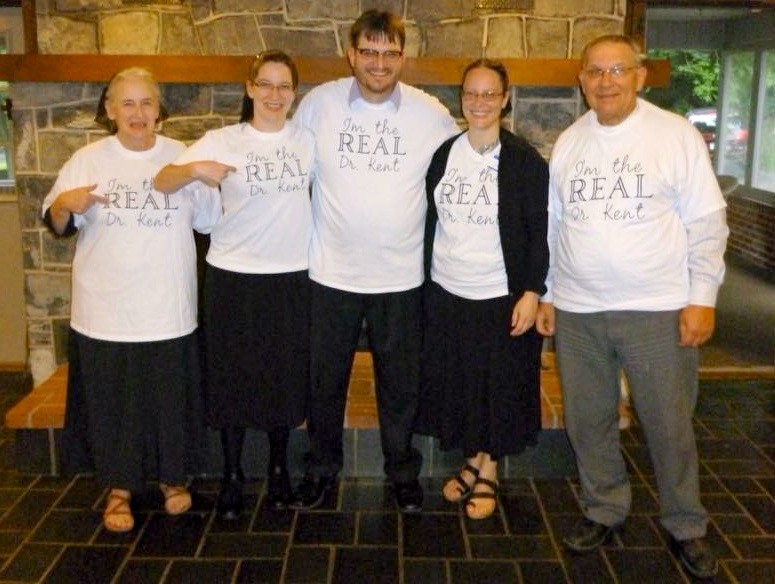Putting physicians on the fast track to family medicine

By Michael Modes
Across the nation, especially in rural areas, America is facing an acute shortage of doctors to practice family medicine. Most medical schools are in big cities, so many small communities lack resources to draw top candidates to their region. With older practitioners retiring and fewer candidates ready to take their place, Penn State College of Medicine launched an accelerated program to allow students to complete medical school in three years and enter practice one year earlier.
In 2017, Dr. James Kent became the first graduate of the accelerated program, which allows students to complete medical school in just three years, followed by a three-year residency at Penn State Health Milton S. Hershey Medical Center.
Part of the College of Medicine’s Family Medicine Accelerated Pathway, also known as a 3+3 pathway, the program allows graduates to save a year of tuition and living expenses, which could add up to $70,000. Kent was also selected for the Chambersburg Longitudinal Integrated Clerkship (LIC), which provides $20,000 in tuition reimbursement if he chooses to practice in one of Summit Health’s underserved areas.
Kent’s parents and three of his six siblings are also doctors, and their College of Medicine classmate, Dr. Dennis Gingrich, became one of Kent’s instructors at the college.
“I went to medical school with both of James’ parents and followed the family over the years,” Gingrich says. “I worked with his sister who also made a career of family medicine and is now working in Africa with underserved patients. James really is part of an incredible family tradition of family medicine.”

Dr. James Kent, center, and his parents and sisters point to themselves as “The Real Dr. Kent.” His mother, Dr. Carolyn Davis Kent, his sisters, Dr. Anna Kent and Dr. Sarah Kent, and his father, Dr. W. David Kent, are also physicians and Penn State College of Medicine graduates.
Despite his background, Kent’s medical career was not a foregone conclusion. “I didn’t expect to become a doctor when I was younger or even go to medical school until my mid-30s,” he recalls. Cutting a year off his education made the College of Medicine’s accelerated program even more appealing.
“James was perfect to be the first student in the accelerated program because he is a mature learner and has had a lot of life experience,” Gingrich explains. “It’s a very challenging program, so it isn’t for everyone.”
“James will be a future leader,” declares Dr. Shou Ling Leong, director of Longitudinal and Accelerated Pathways at the college. “Both the patients and faculty were impressed with him. He is bright, caring and dedicated. Some people worried that the accelerated pathway may be watered-down training, but data has shown that graduates of accelerated programs perform very well as residents.”
Kent learned of the accelerated program and its LIC component after he matriculated to medicine school. “I talked to some people I trusted and decided to apply for it,” he says. “Completing the program in three years had a specific set of challenges, but I’m glad I did it. I was pretty set on family medicine, and the program made a lot of sense for me.”
The clerkship program allows residents like Kent to learn how to treat the whole patient by following each one across varied medical disciplines. By combining interdisciplinary medical knowledge and long-term patient contact, doctors can provide more personalized care. Clinical experience and classroom teaching supplement one another.
“The Longitudinal Integrated Clerkship gave me the opportunity to build some strong relationships with my patient,” Kent points out. “It was valuable because I would see a patient with a disease, then learn about it in the classroom, so the information stuck with me.” That varied approach carries over to his residency at the Milton S. Hershey Medical Center. “The residency is busy, exciting and fun all at the same time. We have many different rotations, specialties and patients, so every day is different.”
Kent grew up in Chambersburg and says he is open to staying in the area and helping to fill the family physician shortage in Franklin County. “I have a time commitment I owe to Summit Health in return for their financial assistance with medical school, but I haven’t necessarily picked my entire career path yet. Community medicine is population health. Family medicine in general is suited to rural health, where there aren’t as many providers. One provider must know how to do a wide breadth of health care services. The LIC prepares you well for that diversity.”
“James has been an ambassador for the accelerated program” says Leong. “He is an incredibly hard worker and just naturally caring, compassionate and patient centered.”
The longitudinal aspect of the program is key to Kent. “That’s my ideal practice, having long-term relationships with family members of multiple generations. I just find that very special and meaningful.” In addition to serving patient families, Kent also finds a tightknit circle of professionals in his field. “Family medicine is communal among the providers. There’s a lot of camaraderie, support and mentoring.”
Kent understands the concerns of accelerating medical school, an extraordinary challenge even in four years. “I think many people have concerns about accelerating medical school, but I really do believe the LIC prepared me as well as any of my intern classmates.”
“James is the best,” sums up his friend and mentor Gingrich. “He’s been making a positive impression with his dedication, empathy and ability on every rotation. That just reinforces my belief that the accelerated program and Longitudinal Integrated Clerkship is an excellent training ground for future family medicine colleagues.”

Dr. James Kent, seventh from left, celebrates becoming the first graduate of Penn State College of Medicine’s Family Medicine Accelerated Pathway in 2017.
If you're having trouble accessing this content, or would like it in another format, please email Penn State Health Marketing & Communications.
